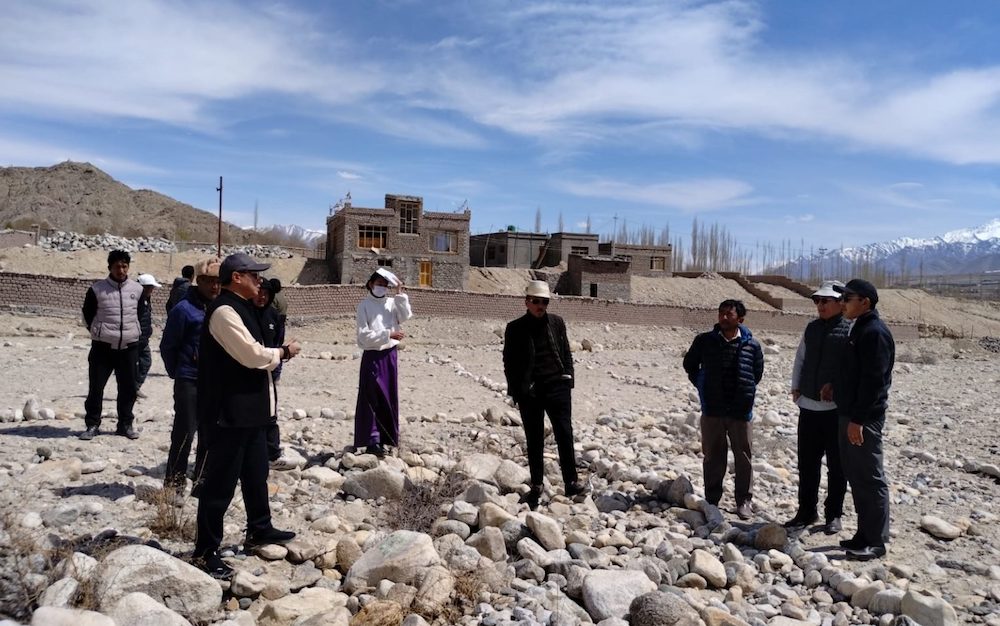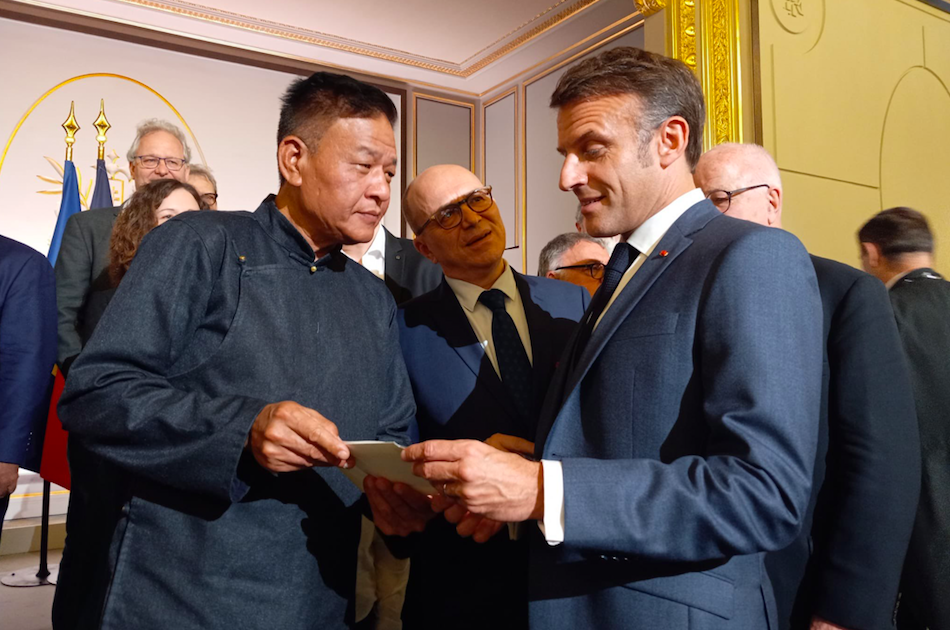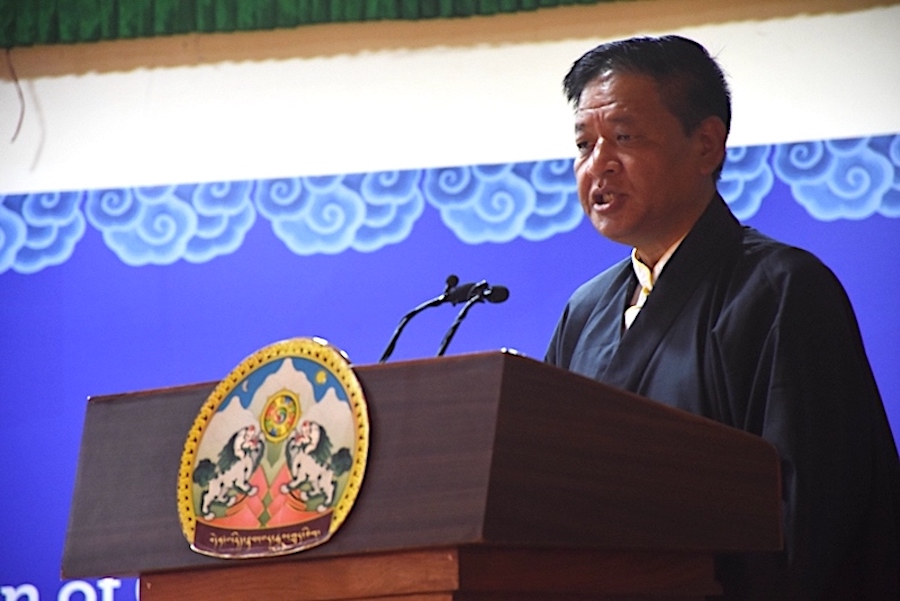By Vijay Kranti
(July-Sep, 2003 issue of BORDER AFFAIRS journal from N.Delhi)
Indian Prime Minister Atal Behari Vajpayee’s visit to China has, once again, proved that irrespective of China’s claims over Tibet, the communist rulers of this Asian colony have yet to come out of their guilty conscience. Before Mr. Vajpayee, a veteran champion of Tibetan cause, left for Beijing the Chinese officials, involved in setting details of the agenda, spent a good part of their efforts to ensure that he would not raise the Tibetan issue in public during his visit. But it was the very own guilty conscience and sense of Chinese insecurity over the Tibetan issue that they spilled the beans on their own.
On 23rd June morning at the time of signing two agreements, one on opening of a new border trade route through Sikkim and the other on mutual cooperation, it was agreed between the two Prime Ministers that a joint communiqué with details of these agreements would be issued after their scheduled meeting same evening. But the over enthusiasm shown by the Chinese propaganda masters, who run the official Xinhua news agency, exposed how desperate and insecure the Chinese rulers are on the question of Tibet.
Without waiting for the joint statement the Xinhua released a news item, which announced that for the first time in history the Indian government had ‘explicitly admitted that Tibet is an inalienable part of China’. By any standards of journalism this information, if true, was news that deserved to be treated as the ‘news story of the year’. Indian media, a typical mirror of the post-1962 inferiority complex ridden Indian psyche, lost no time in lapping the Xinhua story. Almost every news bulletin on most Indian TV news channels ran its lead story announcing “India sells out Tibet to China”. Similarly most newspapers next morning came out with screaming headlines, which sounded like “India surrenders Tibet” or “India barters Tibet for Sikkim”. The Indian complex proved too deep to let the chiefs of news bureau of media groups to wait for the Indian version or to seek clarification of Indian foreign ministry on such a sensitive issue.
On the Chinese side too, this event was an expression of their own complexes arising out of the contrast between the announced Marxist principles of ‘anti-colonialism’ and the reality of their colonial clutches over Tibet. After all modern day Chinese are well aware of the fact that Tibet used to be a free nation until 1951 when Mao’s Peoples Liberation Army (PLA) swallowed Tibet with the same brutal Han might that was used to occupy many other countries like East Turkistan (Sinkiang), Inner Mongolia, Manchuria etc.
It was not the first time that the Chinese rulers tried to get official seal of approval of Indian governmen over Tibet as an ‘inalienable part of China’. Since day-one of Tibetan occupation the Chinese leadership have been itching to win India’s seal of final approval. Earlier Indian governments have been viscilating their response to this Chinese demand between terms like ‘Tibet is a part of China’ and ‘Tibet is an autonomous region of China’. When challenged by the media representatives to clarify the confusion arising out of Xinhua claims Mr. Yashwant Sinha claimed that ‘their is no change in India’s stand on Tibet’. On a later day when Indian claims did not stop the Chinese media from repeating its earlier claims Mr. Sinha tried to cool down the Indian media’s anxiety by claiming that India had articulated its stand on Tibet to a position which makes it more favourable to Tibet. Instead of using term ‘China’ India said that it ‘recognizes’ that ‘Tibet Autonomous Region is a part of People’s Republic of China’.
It is interesting to note that rather than cooling passions in India, this claim of the Indian leaders has only given rise to fresh fears. In a seminar, held immediately after Mr. Vajpayee’s return to India, Mr. Seshadri Chari, Chief Editor of The Organizer, the news weekly known for its pro-BJP colour, explained that the mention of ‘Tibet Autonomous Region’ (TAR) by the Indian government is to underline that China’s claims over Tibet are limited only up to the TAR which is less than half of the real Tibet. (Two provinces of original Tibet namely KHAM and AMDO have been already assimilated by China in the adjoining provinces of Sichuan, Yunnan, Ganzu and Quinghai.) On the use of term ‘People’s Republic of China’ as against ‘China’ used by all previous Indian Prime Ministers in this context, Mr. Chari’s explaination was that this change in GOI’s stand on Tibet reflects India’s desire to put China-Tibet relations in the right perspective. “It underlines the occupied status of Tibet. The basic historical fact is that Tibet was never a part of traditional ‘China’. It was forcibly occupied by ‘Peoples Republic of China’ which itself came into existence only in 1949.” His comment that, “This relation is valid only till PRC exists” put China-Tibet relations at par with the relations that the constituent states of USSR had with Russia until the USSR broke into its original pieces.
In sharp contrast to this Dr. Brahma Chellaney, a noted China scholar and expert on strategic affairs, was of the opinion that by merely using the term ‘recognize’ and by referring to TAR, India has permanently sealed the fate of Tibet as a part of China. He says that by accepting TAR as the real Tibet India has only endorsed the Chinese viewpoint that other parts of Tibet (Kham and Amdo) were never parts of Tibet and that there was no dispute on their accession by China.
The confusion over how kind the Prime Minister Vajpayee has been to the cause of Tibet, which remained his political darling during his earlier role as a fiery leader of opposition, has yet to settle down. What new status is going to be assigned finally to Tibet in the light of latest India-China understanding on Tibet in the Beijing agreement has yet to emerge. But one basic factor that has emerged from the Chinese attitude on this issue is that despite all Chinese claims on Tibet as a ‘historic’ or ‘an inalienable ‘ part of China, the Beijing rulers are never going to come out of their guilty conscience on forcible occupation of Tibet.
Free India’s interaction with China on Tibet started in 1949 when China attacked Tibet and occupied its eastern province of Kham, the home of fiery Khampas, who represented Tibet’s national fighting spirit in the western media during first two decades of Tibetan occupation. This was the very first step taken by Chairman Mao in the direction of giving shape to his South Asian dream that he had expressed earlier in his declaration which said, “Tibet is China’s palm and Ladakh, Nepal, Sikkim, Bhutan and NEFA (now Arunachal Pradesh) are its fingers.” But thanks to Nehru’s fascination for Mao’s communist revolution, he refused to see any threat in this invasion.
Overwhelmed by Premier Chou En-Lai’s public relations skills Nehru accepted the forcible assimilation of Tibet into China in 1951 as the ‘liberation’ of a backward feudal state by a well-meaning progressive socialist government. On the one hand he used all his influence over the young Dalai Lama to ‘cooperate’ with Beijing and on the other he threw his weight behind China to protect it from any action, even discussion, by the UN, then known as United Nations Organisation (UNO). First time in the history of Asia China had a direct geographic interface with South Asia. Pakistan, India, Nepal, Sikkim and Bhutan suddenly discovered that China was their new neighbour on their northern borders.
Nehru and India had their first taste of the Chinese reality when the PLA butchered over 80 thousand Tibetans and Dalai Lama had to flee to India following a failed public uprising against the occupying Chinese army in Lhasa and other parts of Tibet. The push came to a shove for a disillusioned and shocked Nehru when China used the occupied Tibet as a Chinese military base and attacked India. A surprised, unprepared and ill equipped Indian Army faced a complete humiliation at the hands of China who, until the last day, were not tired of defining relations with India through the well known slogan “Hindi-China Bhai-Bhai” (India and China are brothers).
1962 marked the watershed in India-China relations. Since then China’s South Asian policy has been religiously focused on weaning away Pakistan, Nepal, Bhutan, Myanmar, and later Bangla Desh too, from Indian influence and creating all possible conditions in these countries, which promoted local hostility towards India and her regional interests.
Beijing’s most remarkable success was Pakistan, an erstwhile ally of the anti-communist western block. It soon turned out to be an ally who is more than willing to play as China’s nuclear as well as conventional military proxy in containing India. While good relations with Pakistan and Myanmar have helped China in extending its military arm right up to the Arabian Sea and Indian Ocean respectively, its defence treaty with Bangladesh has made entire northeastern region of India highly vulnerable. It is ironic that Bangla Desh happens to be the same country that won its freedom with India’s help and whose birth and recognition as a member of the world community were opposed tooth and nail by none other than China.
In the case of Nepal and Bhutan too China has gone a big way in weaning away the two Himalayan countries from the Indian zone of influence. While Nepal has slowly emerged as a convenient playground of pro-China, pro-Pakistan and many other China sponsored anti-Indian forces in recent decades, Bhutan too has become a safe heaven for pro-China and anti-India terrorist and separatist groups like the ULFA and KLA. These groups draw political, financial and strategic support from Beijing and have been sending their member to Chinese occupied Tibet for training in subversive activities.
China too has been living quite an uneasy life with the subjects of its Tibetan colony. Despite a tight military control over Tibet, Beijing has failed in winning over the Tibetan hearts in past 50 years. Even after all possible efforts to destroy Tibetan religion and running a much longer and harder ‘Cultural Revolution’ inside Tibet the Chinese masters have failed in winning over the Tibetans from emotional influence of the exiled Tibetan ruler Dalai Lama. All this has encouraged the Chinese leaders to use their time-tested tool of ethnic cleansing and demographic overwhelming – a policy that has shown remarkable results in many other similar problematic regions like Inner Mongolia, Manchuria and Sinkiang.
Millions of Chinese are being settled inside Tibet. The two Tibetan provinces of Kham and Amdo, which were scooped out of Tibet and assimilated in the adjoining Chinese provinces of Sechuan, Yunnan, Ganzu and Qinghai soon after the occupation of Tibet, have been already converted into regions of overwhelming Chinese character. Going by various policy statements issued by prominent Chinese leaders and Beijing’s special Work Groups on Tibet in the past, conversion of the remaining part of Tibet, known as Tibet Autonomous Region (TAR), into an overwhelming Han country is only a matter of time.
A significant step being taken by Beijing to seal the fate of Tibet through demographic invasion of Tibet is the upcoming Railway project in TAR. Undertaken at a mind-boggling cost of US $ 27.2 billion, this project will connect Lhasa to four major Chinese centers. These are Gormo in Qinghai (1118 km), Lanzhou in Gansu (2126 km), Dali in Yunnan (1594 km) and Chengdu in Sechuan (1927 km). When completed, this railway network is going to convert Tibet permanently into a region of overwhelmingly Chinese character. Justifying the extraordinary cost of this four-stage railway project, Chinese Premier Jiang Zemin had termed it as a ‘political project’. The construction work of the first Gormo-Nagchu-Lhasa phase is already running at full steam and is expected to start ferrying Chinese settlers, defence equipment and personnel from Qinghai in 2007.
Once first phase of this project is complete, this railway line is going to bring a basic change in the character of occupied Tibet. From a country sparsely populated by unhappy Tibetans and difficult geographic conditions, TAR will soon be a region of overwhelming Chinese character and equipped with reliable mass transport system that will make Indian defence preparedness along Himalayan borders meaningless. One should hope that the authors of India’s new China policy will not let the Chinese dragon have the last laugh as it had in 1962.
VIJAY KRANTI can be contacted at vijaykranti@vsnl.com









